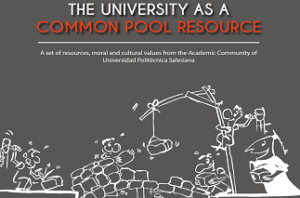The University as a Common Pool Resource
Set of resources, moral and cultural values of the academic community of the Salesian Polytechnic University.
This book gathers the contributions of the Common Goods Research Group of the Salesian Polytechnic University, created in 2016 to deepen and identify the implications and possibilities of imagining the university as a “commons”. This option must be explained as the connection of the use of the commons – as understood by Elinor Ostrom in her work The Governance of the Commons. The Evolution of Collective Action Institutions (2011) – with the possibility of rethinking the university across the board is neither immediate nor coincidental and, at first glance, such a connection sounds strange in times when we assess relevance based on evidence accessible at first glance.
Herrán, J., Salgado, J.P., Juncosa, J., Carrera, P., Torres-Toukoumidis, A., & Romero-Rodríguez, L.M. (2018). The University as a Common Pool Resource. Abya Yala. https://www.romero-rodriguez.com/download/2030/


